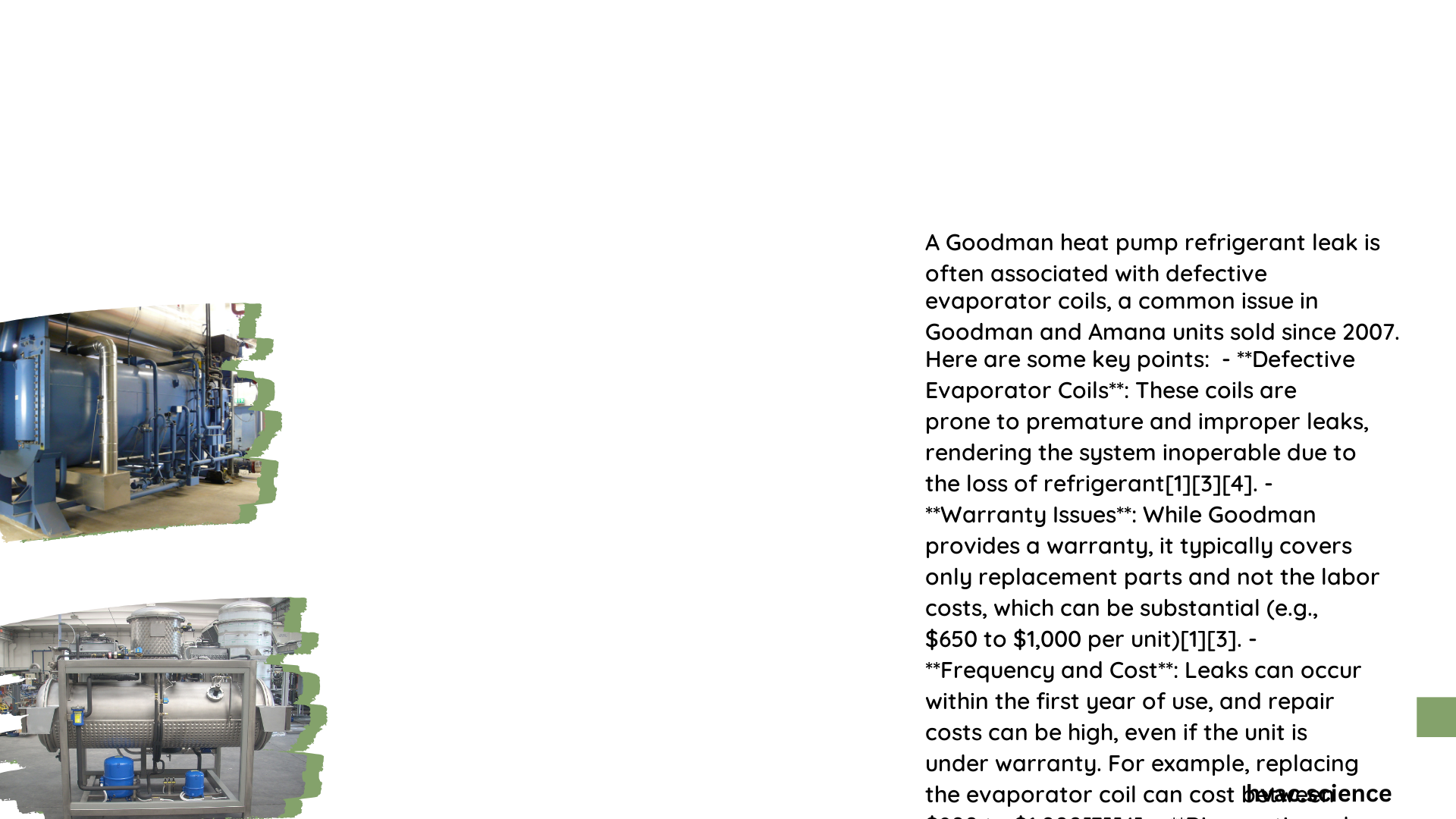A Goodman heat pump refrigerant leak can significantly impact the efficiency and performance of your HVAC system. Detecting and addressing these leaks promptly is crucial for maintaining optimal heating and cooling in your home. This comprehensive guide explores the symptoms, detection methods, repair processes, and associated costs of Goodman heat pump refrigerant leaks, providing valuable insights for homeowners and HVAC professionals alike.
What Are the Common Symptoms of a Goodman Heat Pump Refrigerant Leak?
Identifying a refrigerant leak in your Goodman heat pump is the first step towards resolving the issue. Here are the key symptoms to watch out for:
- Unusual Noises
- Hissing or bubbling sounds
-
More noticeable in quiet environments
-
Reduced Performance
- Longer cooling or heating times
-
Inadequate temperature control
-
Visual Indicators
- Ice buildup on refrigerant lines
-
Frost on the outdoor unit
-
Greasy Residue
-
Oily film on or around the outdoor unit
-
Temperature Anomalies
- Indoor coil freezing
- Compressor or copper tubes at room temperature
How Can You Detect a Goodman Heat Pump Refrigerant Leak?

Detecting a refrigerant leak requires a systematic approach and specialized tools. Here’s a step-by-step process:
- Visual Inspection
- Check for oil stains around connections
-
Look for signs of corrosion or damage
-
UV Dye Method
- Add UV dye to the refrigerant system
-
Use UV light to locate the leak
-
Electronic Leak Detection
- Utilize an electronic leak detector
-
Pinpoint the exact location of the leak
-
Pressure Testing
- Measure system pressures
- Compare with normal operating ranges
Where Are the Most Common Leak Locations in Goodman Heat Pumps?
Understanding the typical leak locations can help in faster diagnosis and repair:
- Evaporator Coil
- Often the primary source of leaks
-
Check capillary metering device
-
Service Valves
- Frequently overlooked due to gauge hoses
-
Inspect for overheating damage
-
Outdoor Unit
- Most leaks originate here
-
Listen for hissing sounds and check for visual signs
-
Refrigerant Lines
- Examine connections and joints
- Look for signs of wear or damage
What Types of Refrigerants Are Used in Goodman Heat Pumps?
Goodman heat pumps typically use the following refrigerants:
- R-410A
- Common in modern units
- Higher pressure than R-22
-
Requires specific handling equipment
-
R-22 (Phased Out)
- Used in older models
- No longer manufactured due to environmental concerns
| Refrigerant | Pressure | Environmental Impact | Compatibility |
|---|---|---|---|
| R-410A | High | Lower | Modern units |
| R-22 | Lower | Higher (Phased out) | Older models |
How Much Does It Cost to Repair a Goodman Heat Pump Refrigerant Leak?
The cost of repairing a refrigerant leak can vary based on several factors:
- Labor Costs
- Range: $50 to $150 per hour
-
Depends on technician and location
-
Material Costs
- Evaporator coil replacement: $800 to $1,000
-
Varies based on model and size
-
Time Estimates
- Simple repairs: 2-3 hours
- Complex issues: Up to a full day
Factors influencing repair expenses:
– Warranty coverage
– Technician expertise
– Leak location and accessibility
– Extent of damage
What Are the Steps for Repairing a Goodman Heat Pump Refrigerant Leak?
Repairing a refrigerant leak involves several crucial steps:
- Leak Detection
- Use electronic detectors or UV dye
-
Identify all leak points
-
System Evacuation
- Remove remaining refrigerant
-
Ensure proper disposal
-
Component Repair or Replacement
- Fix minor leaks if possible
-
Replace severely damaged parts
-
Pressure Testing
- Check system integrity
-
Ensure no new leaks
-
Refrigerant Recharge
- Add the correct type and amount of refrigerant
- Test system performance
How Can You Prevent Future Goodman Heat Pump Refrigerant Leaks?
Preventing future leaks is essential for maintaining your heat pump’s efficiency:
- Regular Maintenance
- Schedule annual professional inspections
-
Clean coils and check for signs of wear
-
Prompt Repairs
- Address minor issues immediately
-
Don’t ignore unusual noises or performance changes
-
Quality Installation
- Ensure proper initial setup
-
Use qualified technicians for all work
-
System Upgrades
- Consider replacing older units
- Opt for models with improved leak resistance
By understanding the signs, detection methods, and repair processes for Goodman heat pump refrigerant leaks, homeowners can ensure their HVAC systems operate efficiently and effectively. Regular maintenance and prompt attention to potential issues can save both time and money in the long run.
References:
1. https://ushvacwarehouse.com/how-to-detect-refrigerant-leaks-in-your-ac/
2. https://repair.oncoursehome.com/blog/signs-that-heat-pump-has-refrigerant-leak/
3. https://www.contractortalk.com/threads/goodman-units-are-leaking-freon.70220/
